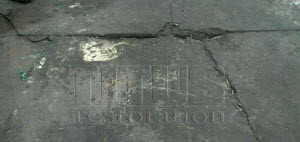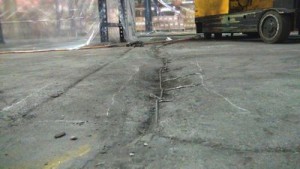Many concrete warehouse floors have damage at the joints. This is caused by poor slab construction, improper use of slab, and most commonly: unfilled control joints. When hard, wheeled traffic runs over unfilled joints, they are susceptible to chipping away, spalling, and eventually eroding away completely. Many times repairing concrete control joints is performed by pouring epoxy into the voids, but this temporary fix quickly fails causing frustrations once again. Read more about our concrete joint repair here.
A Final Fix for Concrete Control Joints
 Minor Damage – Minor concrete joint damage is the ideal time for joint repairs. Most importantly, this option is more economic, but in addition, repairing concrete control joints before the damage becomes too severe is better for your floor. The 6-Step Process shown below is followed for a permanent fix and it is highly recommended that all joints be filled at this time.
Minor Damage – Minor concrete joint damage is the ideal time for joint repairs. Most importantly, this option is more economic, but in addition, repairing concrete control joints before the damage becomes too severe is better for your floor. The 6-Step Process shown below is followed for a permanent fix and it is highly recommended that all joints be filled at this time.
 Major Damage – Major joint deterioration calls for a larger scale rebuilding process, but the same steps are followed to achieve a lasting floor joint repair.
Major Damage – Major joint deterioration calls for a larger scale rebuilding process, but the same steps are followed to achieve a lasting floor joint repair.
Unstable Concrete The Underlying Issue of Concrete Joint Damage
Concrete joint damage is a common warehouse problem that can be address on the surface if it is due to traffic and lack of prevention issues. However, if the concrete is sinking at the joints, this is a different story. Sinking, rocking, or unstable concrete is an indication of a much more severe issue. The soils and subbase of the concrete can become loose and voids can occur beneath the slab causing these major issues. Fortunately, there are ways to stabilize and fill the voids so that your concrete is restored to sound surface where forklifts are able to run uninterrupted.
Titus Restoration is certified in repairing concrete control joints in warehouses and factories across the Southeast US. Our results have proven lasting and our customers are pleased with our hard work and dedication to getting your projects done.
